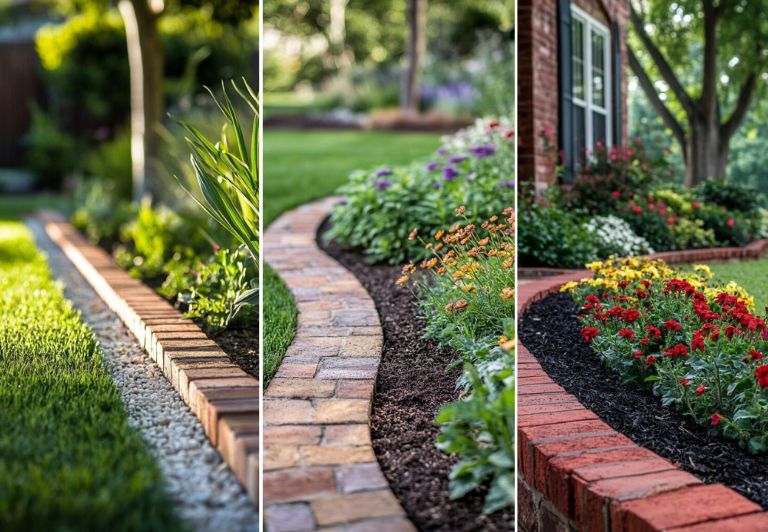How To Lay Brick Border Garden Edging? [Easy DIY Guide]
Adding a brick border to your garden is an easy way to create a neat, defined edge between your lawn and flower beds.
You can lay brick edging by digging a shallow trench, placing the bricks tightly together, and making sure they are level so your garden border stays in place and looks professional.
This method keeps soil and mulch where they belong. It also helps stop grass from spreading into your garden.
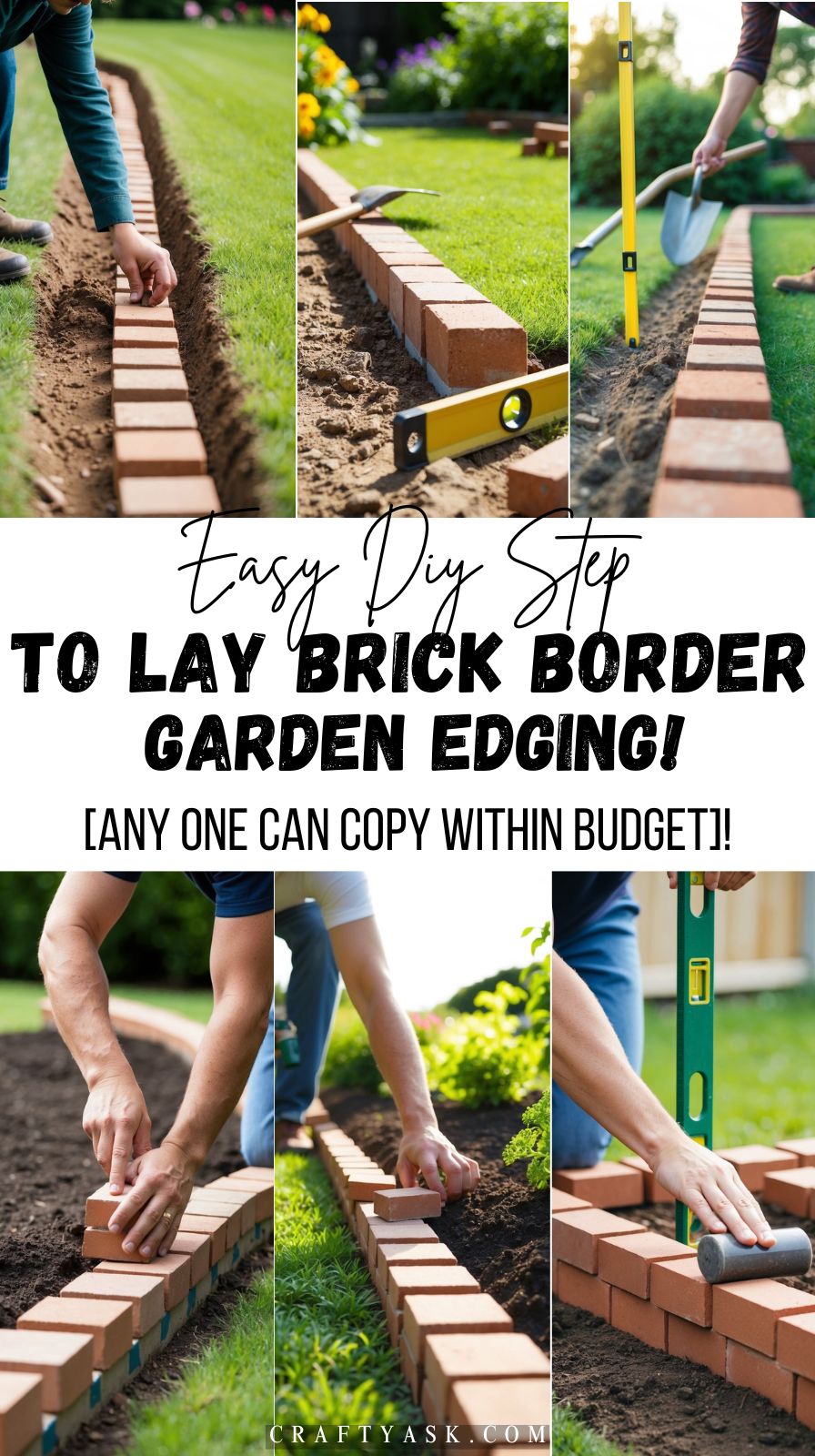
With some simple tools and a little time, you can get impressive results without having to hire a professional.
Homeowners of any skill level can follow these steps to give their yard a clean, organized look that lasts.
Planning Your Brick Border

Laying a brick border starts with careful planning. Location, brick choice, and layout all make a difference in how your garden edge will look and last.
Choosing the Right Location
Pick a spot where you want to define an edge. Many people use brick borders to separate flower beds, lawns, or walkways.
Look for areas where grass and plants are spreading too much or where a cleaner line is needed. Avoid placing brick borders in spots with poor drainage or heavy roots, as these can shift bricks over time.
Make sure the ground is as flat as possible. This makes digging and leveling the bricks easier.
Survey the area and keep sight lines in mind for the best visual effect. If your yard has curves or corners, decide if you want the border to follow them or go straight.
Curves may take more time and careful brick placement. Take photos or draw a quick sketch to help picture your finished border.
Selecting Suitable Bricks
Bricks come in many types, such as clay, concrete, or reclaimed. For best results, use bricks made for outdoor use.
Regular indoor bricks may break down outside, especially after rain or frost. Think about the color and texture that will match your yard.
Red bricks give a classic look, while grey or tan bricks blend with modern landscapes. Choose a size that fits your design, like standard bricks for a simple edge or wide pavers for a bolder look.
Build your list of needed materials based on the total length of your border. It’s helpful to buy a few extra bricks to allow for mistakes or future repairs.
Measuring and Marking the Edging Layout
Start by measuring the edge you want to border using a tape measure. Write down the total length so you know how many bricks you’ll need before you begin.
Mark out the edge by laying a rope, garden hose, or spraying a painted line. This helps you see the shape and make changes before digging.
For straight lines, stretch a mason’s line for guidance. Plan brick spacing for a tight fit, unless you want gaps for plants or drainage.
Accurate marking and measuring makes digging your trench much easier. This ensures your brick edging follows your chosen path.
Gathering Tools and Materials

You need the right tools to make sure each brick is set straight and secure. Picking proper materials will keep your brick edging stable, even after heavy rain or foot traffic.
Essential Tools Checklist
Having the correct tools makes the job much easier. Here is a simple checklist:
| Tool | Purpose |
|---|---|
| Shovel or Spade | Digging and shaping the trench |
| Hammer/Mallet | Tapping bricks in place |
| Level | Ensuring the bricks are even |
| Tape Measure | Measuring the area |
| Garden Stakes | Marking the border line |
| Mason’s Line | Guiding a straight edge |
| Wheelbarrow | Carrying bricks and soil |
| Gloves | Protecting hands |
A shovel will help you dig out the correct shape for your border. A mallet lets you press bricks securely into position.
Using a level helps keep the border smooth and visually straight from every angle. Stakes and mason’s line make sure your edging follows the planned path.
Gloves are important to prevent blisters or injuries. A wheelbarrow helps move heavy materials directly to your work area.
Your work will go faster and more smoothly if you prepare all these tools in advance.
Materials for Stability and Durability
Choosing the right materials will keep your brick edging strong and looking good. You should have bricks made for the outdoors, such as clay pavers or concrete bricks.
These resist cracking and fading. Paver sand or leveling sand is used to form a flat foundation.
It helps stop bricks from shifting over time. Some guides recommend using paver sand to hold bricks in place.
You will also need landscape fabric to keep weeds from growing between the bricks. If your soil is loose or sandy, you might want gravel for extra support under the sand layer.
Use enough sand and fabric to match the length of your border. If you want to secure the bricks even more, consider concrete edging or a small amount of mortar for added stability, especially in areas with heavy foot traffic or changing weather.
Preparing the Ground for Brick Edging
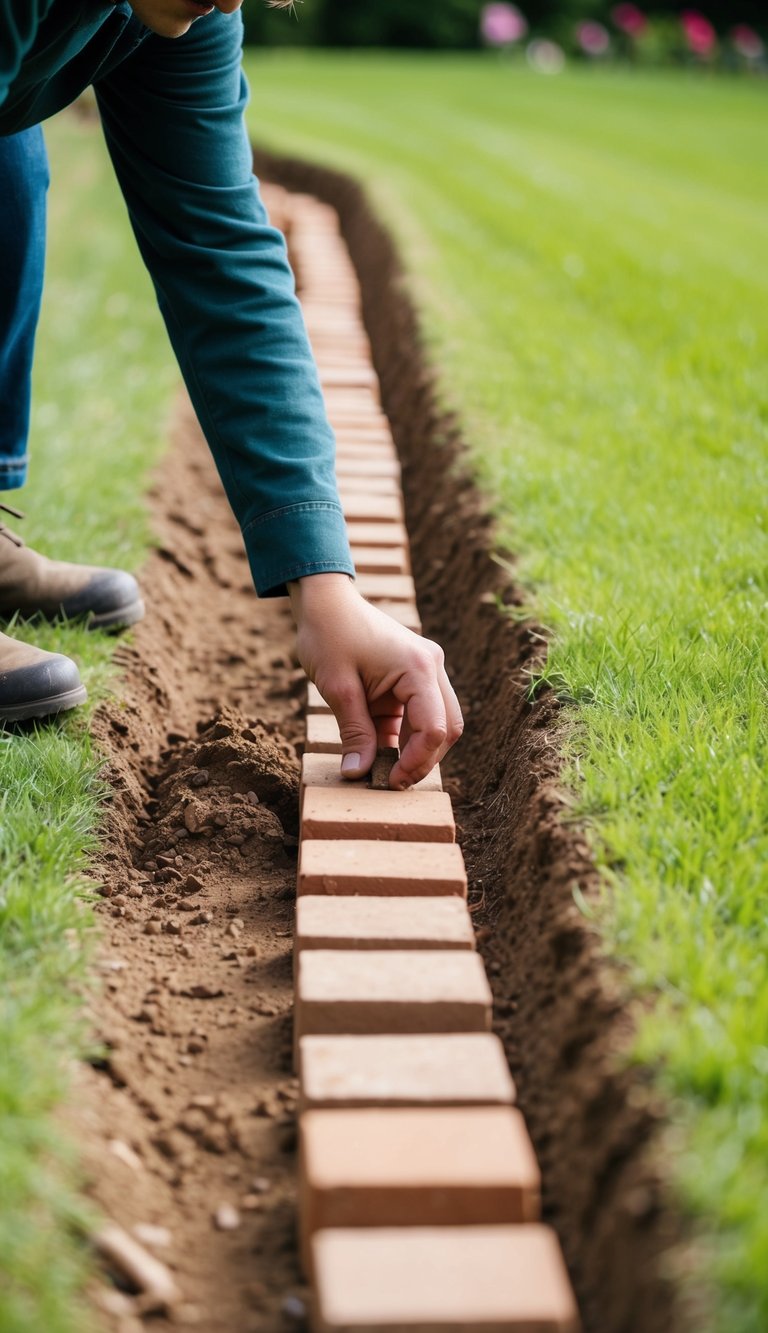
Proper preparation is important for a long-lasting brick border. Your first steps include clearing, digging, and making a solid, level base for the bricks.
Clearing the Edging Area
Start by deciding exactly where you want your brick border to go. Use a garden hose or string to outline the path so you have a visual guide.
Remove grass, weeds, rocks, and any loose debris from the area. It’s best to use a flat shovel for stripping away sod.
Getting rid of roots now will help prevent them from pushing up bricks later. If you notice uneven ground or obstacles, take time to smooth them out.
This helps you avoid gaps and uneven bricks in the finished edge. Double-check the shape you want, adjusting the line if needed, before you move on.
Excavating a Trench
Dig a trench where your layout marks are. The trench should be about twice as wide as your bricks and deep enough to fit both the bricks and a layer of base material.
For most projects, a depth of 4 to 6 inches is enough to hold a few inches of gravel and still allow the bricks to sit level with or slightly higher than the ground.
You may need to dig a little deeper if your soil is loose or sandy. Keep the trench sides as straight as possible.
Use a spade for clean edges. Pile the dirt neatly to the side since you may use some for backfilling later.
Remove any large rocks or roots as you dig so you get a smoother base for your bricks.
Leveling and Compacting the Base
Pour a layer of crushed stone or gravel into the trench. This layer helps with drainage and keeps your bricks from shifting over time.
The base gravel should be about 2 to 3 inches deep. Use a steel tamper or a hand tamper tool to pack the material down firmly so there are no loose spots.
After tamping, check the base with a carpenter’s level. Add or remove base material as needed to make sure it is even across the length of the trench.
A level, firm base gives your bricks stability and prevents them from becoming uneven, as explained in guides from The Home Depot.
If your ground is on a slope, build up the lower side with extra gravel to keep the top surface level.
Laying the Foundation
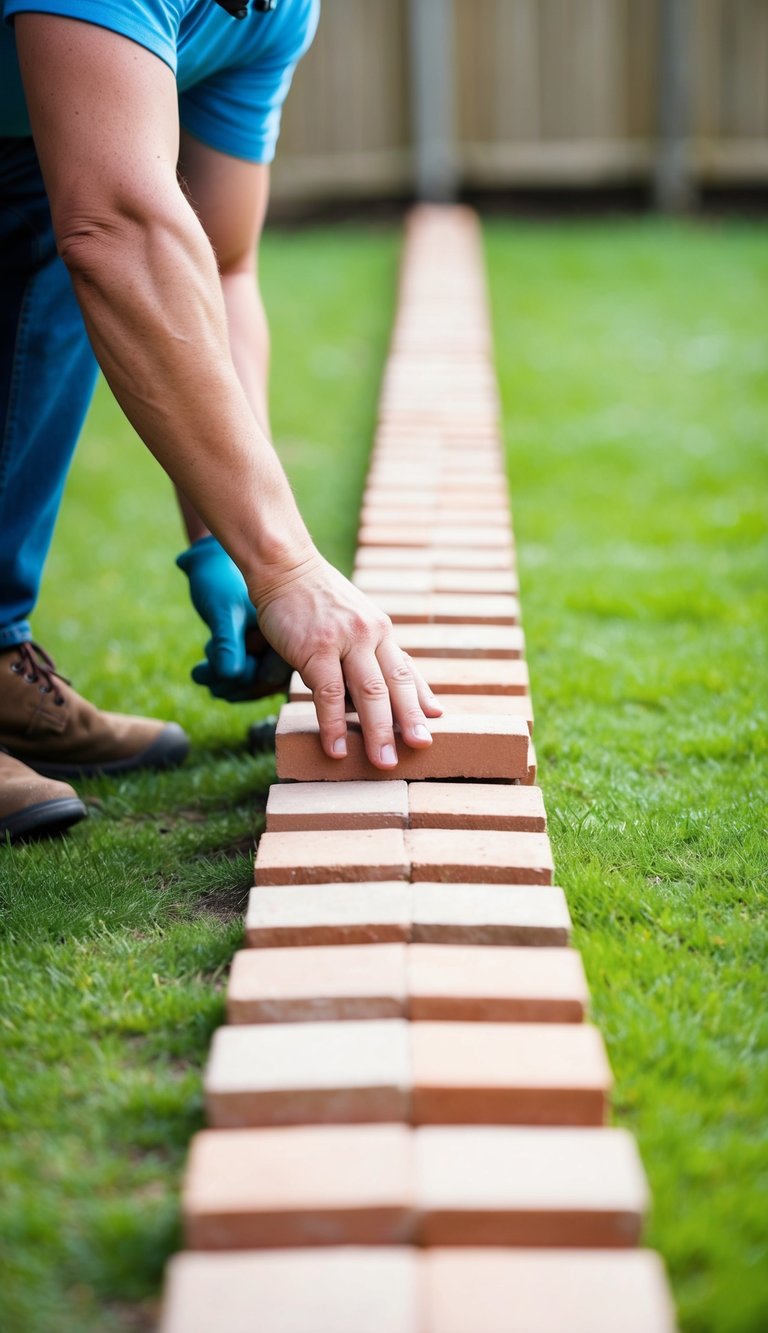
Setting a solid base for your brick border keeps the edging from shifting or sinking over time. Using the right materials and methods is key to making your border last and look neat.
Adding and Leveling Sand or Gravel
Start by digging a trench about 6 inches deep and 4 inches wide, following your planned line for the border. This trench should match the length of your area, with straight sides and a flat bottom.
Pour about 2-3 inches of coarse sand or gravel into the trench. Both materials help to create a firm, stable surface for bricks.
Gravel offers more drainage and is best for wetter areas, while sand is easier to level. Use a hand tamper or the back of a shovel to pack down the sand or gravel well.
This stops the base from settling later. Next, place a long board across the trench and run a level over it.
Adjust and smooth the sand or gravel so it is even. It may help to add more sand or gravel in low spots and tamp again until the whole trench is flat.
Keeping the base level from edge to edge is important to get a neat finished border.
Ensuring Proper Drainage
Proper drainage in the foundation area keeps water from building up under the bricks, which can lead to frost heave and shifting. Gravel under the bricks acts as a drainage layer, letting water move down and away from the edge.
If you are using only sand in a dry area, make sure it is not packed too tightly so water can still seep through. In wetter soil or places with heavy rain, gravel provides better drainage than sand alone.
Check the trench before adding base material to make sure water flows away from buildings or pathways. You might need to slope the bottom of the trench very slightly, around 1/4 inch per foot, so water drains outward.
After placing your bricks, leave small gaps between them or use a porous material for backfilling so water can escape. These steps prevent the formation of muddy puddles or erosion along your new brick edging.
Using these practices as shown in detailed guides on brick edging will improve the durability of your garden border.
Installing the Brick Border
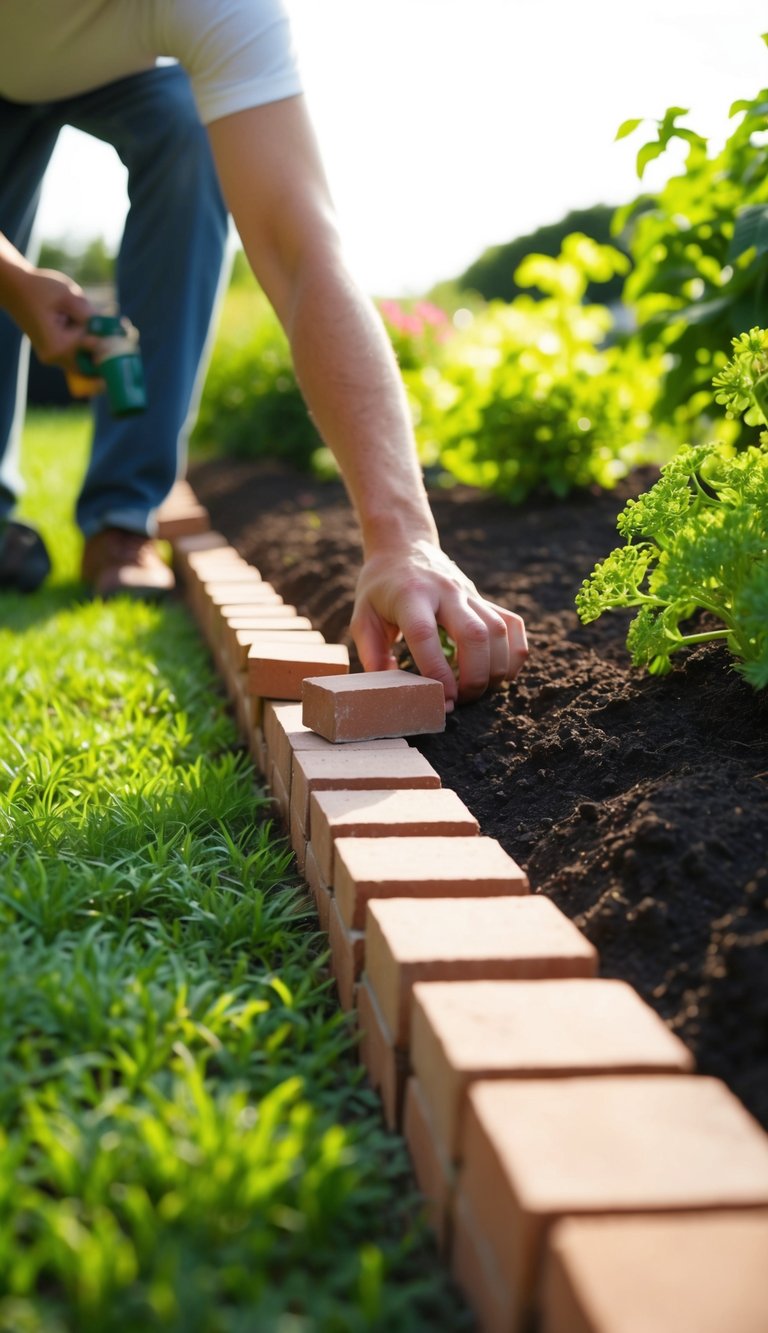
Laying a brick border well takes time and careful attention. Making sure every brick sits level and fits snugly helps your edging stay strong and look neat.
Placing Bricks in the Trench
Start by setting bricks into the trench you dug along the edge of your garden bed. Place each brick flat for a simple look, or angle them for a different style.
Make sure the bottom of the trench is smooth. Use sand or crushed stone as a base for better drainage and stability.
Tap each brick down with a rubber mallet so it sits firmly in place. If you’re working on a curve, adjust each brick slightly to match the shape you want.
Keep the bricks as close together as possible to avoid gaps. If a brick does not fit, trim it with a brick chisel or a masonry saw.
Fill small gaps under bricks with sand and compact it down.
Aligning and Spacing the Bricks
Once your bricks are in the trench, check that they are straight and evenly spaced. Use a mason’s line or string across the length of your border as a guide.
Set bricks flush with the ground if you want to make mowing easier. Raised bricks can catch mower blades.
If your border bends or turns, adjust the space between bricks to keep the curve smooth. Lay out several bricks dry (without mortar) before placing them to see how they fit together.
For a tight, clean line, use a level often and step back to check your progress. Check for consistent spacing from one brick to the next.
The most common method is to press them tightly together, but you may leave small gaps if you like the look.
Setting Bricks for Different Patterns
There are a few ways to set the bricks for a neat border. The most common patterns are:
- Soldier course: Bricks stand up on end, tall and narrow.
- Rowlock course: Bricks lay on their long edge.
- Stack bond: Bricks laid flat, side by side.
Pick a pattern based on the look you want and your garden’s shape. The Home Depot guide to brick edging explains standard brick layouts if you need more detail.
If your bed has sharp curves or corners, you may need to cut some bricks to fit. Always double-check the fit before moving on to the next section.
For extra stability, backfill the trench with soil or sand after placing the bricks. This keeps your border from shifting with time.
Securing and Finishing the Edging
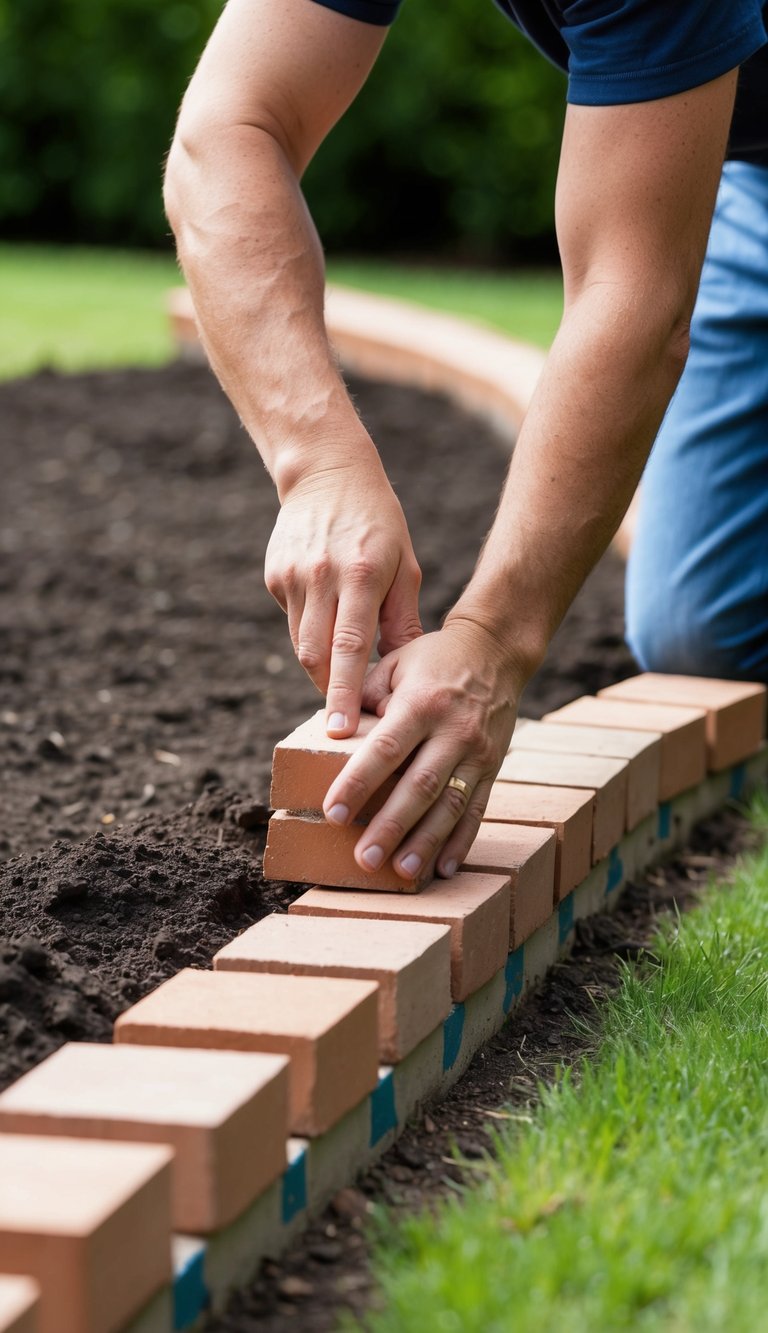
Once your bricks are in place, you need to make them stable and give the border a finished look.
Backfilling and Tamping Edges
Start by backfilling both sides of your brick edging with soil. Use a shovel to pack it gently but firmly against the bricks.
This helps hold them in place and prevents them from shifting over time. If you want a very secure border, fill in any low spots so the bricks sit evenly and do not wobble.
Use a hand tamper or the flat side of your shovel to tamp the soil down. Firm tamping keeps the bricks from moving when you mow or walk near them.
Be sure to step back and check that your line of bricks stays straight and level as you work.
- Backfill each side with soil.
- Tamp soil firmly.
- Check for a straight and level line.
- Re-adjust if needed.
Filling Joints With Sand or Mortar
Fill the gaps between each brick with sand for a flexible, simple finish. Sweep polymeric or play sand into the joints, making sure the gaps are filled to the top.
If you want a more permanent hold, use mortar instead of sand. Mortar creates a solid hold but takes more time and effort.
After applying sand, mist it lightly with a garden hose. This helps the sand settle and keep the bricks snug.
For mortar, smooth the surface with a trowel and clean any extra mortar before it dries. Make sure joints are fully filled to keep weeds from growing between the bricks.
Cleaning and Sealing the Bricks
Once the joints are filled, clean the bricks with a stiff brush to remove loose dirt, sand, or mortar. Use clean water to rinse them so you do not leave stains or haze.
Avoid using too much water, which can wash away joint material. Let the bricks dry for a day or two.
After they are dry, apply a brick sealer if you want extra protection from water, stains, and moss. Use a paint roller or sprayer for even coverage.
Sealing keeps your edging looking fresh and can extend the life of your bricks, especially in wet climates. For more, watch how to finish garden bed edging with brick borders.
Maintenance and Upkeep of Brick Borders
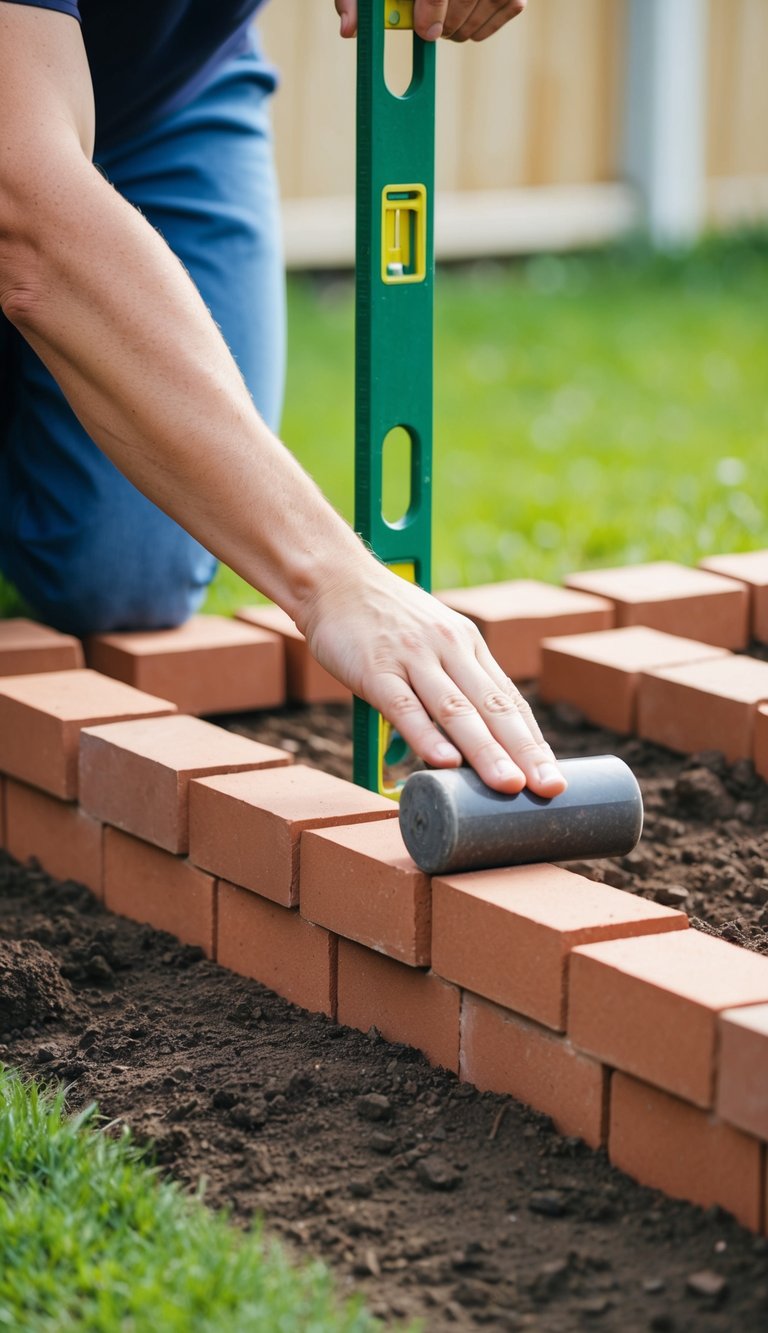
Keeping your brick border looking neat takes regular care and some basic repairs.
Routine Cleaning Tips
Dirt, grass clippings, and moss can build up on your brick border. Sweep the bricks every couple of weeks with a stiff broom.
This helps get rid of leaves and other debris before they stain the bricks. If you notice moss or algae, scrub the bricks with water and a little bit of mild dish soap.
Avoid harsh chemicals because they can hurt your plants. For tougher stains, use a mix of water and white vinegar.
Scrub gently with a brush, then rinse well with clean water. Weeds sometimes grow in the gaps between bricks.
Pull weeds by hand or use a weeding tool. Mulch can also help keep weeds from coming back.
For bricks set in sand, top off the gaps with new sand as needed to keep the border steady.
Repairing Loose or Shifted Bricks
Bricks can loosen or shift over time from rain, soil movement, or foot traffic. Check your border each season and note any bricks that are no longer level or out of place.
If you find a loose brick, lift it out and clear away dirt or debris from the spot. Add some fresh sand or soil, then press the brick back in place so it is flat and even with the others.
For bricks set in mortar, you may need to apply a bit more mortar to reset them. If many bricks are shifting in one spot, consider digging up the section and re-leveling the base.
Make sure the ground is compacted before laying the bricks back down. See detailed guides for tips on how to install and adjust brick garden edging if you need more help.
Creative Design Ideas for Brick Edging
You can choose from many patterns when installing brick edging for your garden. Common options include straight lines, curves, and even zigzags.
Classic Row: Lay bricks end-to-end in a straight trench for a neat border. This is simple and works in most spaces.
Diagonal or Herringbone: Turn your bricks at an angle to create a more interesting look. A herringbone style adds texture and is a favorite for walkways and borders.
| Pattern | Description |
|---|---|
| Flat/Row | Bricks laid flat and side by side |
| Soldier | Bricks laid standing up, side by side |
| Herringbone | Bricks placed at angles, interlocking pattern |
| Basket Weave | Bricks in pairs, each set at a right angle |
Curves offer a softer look around flower beds. If you want a creative edge, try waves, circular borders, or connect short straight sections with tight curves.
You can mix brick colors or use reclaimed bricks for a rustic effect. Choose contrasting or matching shades to highlight garden features.
Add a twist with vertical edging by placing bricks upright, known as a soldier course. For more inspiration, check out creative brick landscape edging ideas to see different looks that might fit your yard.
Eco-Friendly Practices for Garden Edging
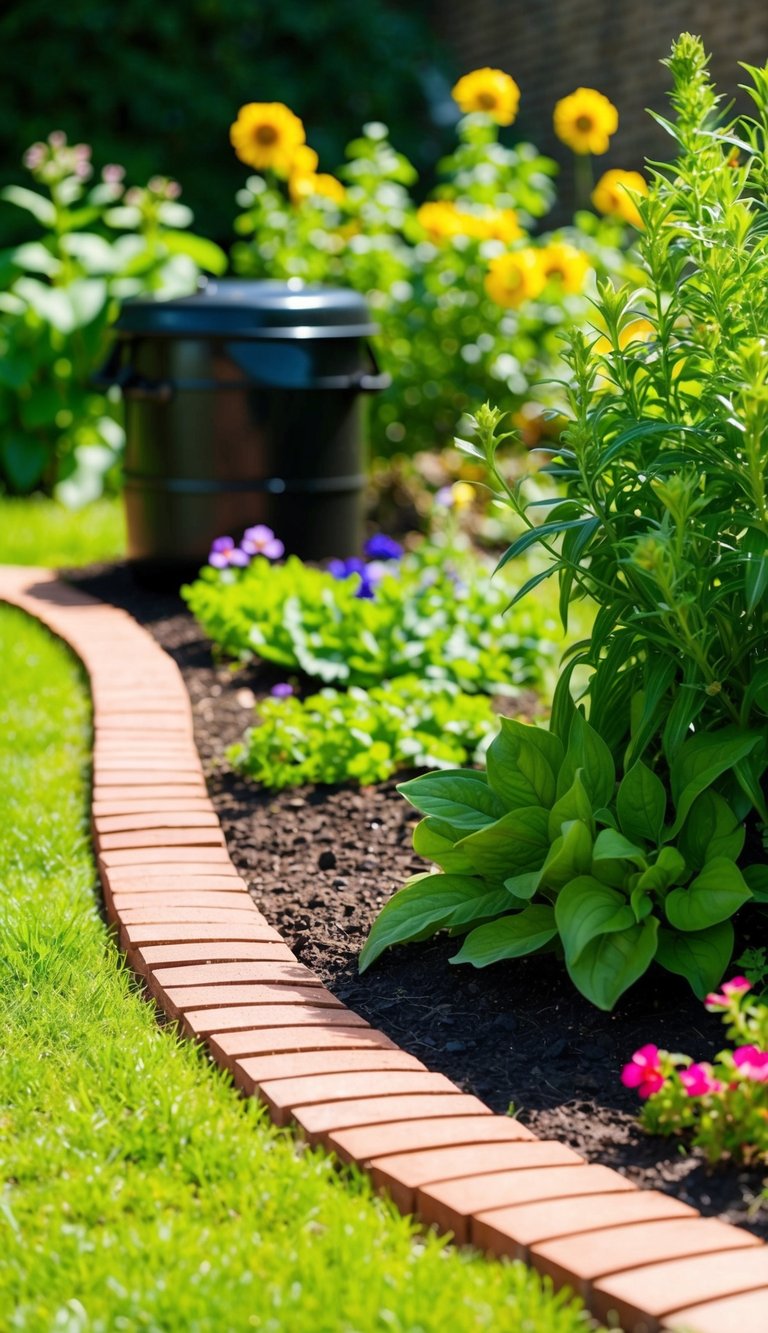
Choosing eco-friendly options for your garden edging helps protect the environment and supports healthy soil and plants.
One simple choice is to use bricks made from recycled materials or reclaimed bricks from older buildings. This reduces waste and avoids producing new materials.
Use these tips for greener edging:
- Pick recycled or salvaged bricks when possible
- Avoid chemical sealants on your borders
- Use sand or crushed stone as a base instead of concrete
Another earth-friendly option is to skip bricks and try recycled rubber edging. Brands now offer lighter, recycled rubber borders that are easy to install and last long.
If you want to avoid using materials completely, create a simple edge using only a spade to cut a trench. This method shapes the bed while letting rainwater soak in naturally and doesn’t introduce any extra product to your yard.
Eco-friendly garden edging benefits:
| Practice | Environmental Benefit |
|---|---|
| Recycled bricks | Reduces landfill waste |
| No chemical sealants | Keeps soil and water cleaner |
| Digging a trench edge | No material production needed |
Choose the method that works best for your space and your goals. Eco-friendly options are practical and support a healthy landscape.
Common Mistakes to Avoid When Laying Brick Borders
1. Uneven Ground Preparation
Not leveling the ground before laying bricks can cause an uneven border.
Always dig a trench that is flat and even.
Use a level to double-check your work.
2. Skipping the Base Materials
Do not lay bricks straight onto soil.
Use a layer of sand or gravel at the bottom of your trench.
This helps keep the bricks stable and prevents them from shifting.
3. Inconsistent Spacing
If you leave gaps between bricks, grass and weeds can grow through.
Position each brick closely together for a tidy look and to make mowing easier.
For tips on spacing, see this guide.
4. Forgetting to Set the Bricks
Bricks that are not properly set can become loose over time.
Press each brick firmly into the base material.
Tap it with a mallet to secure it.
5. Laying Bricks Too High or Too Low
If bricks sit too high, you could trip on them or damage your mower.
Place them level with the ground so you can mow right over the top.
Brick edging advice suggests keeping the bricks flush with your lawn.
Common Problems Table
| Mistake | Effect |
|---|---|
| Uneven base | Crooked, unstable border |
| No base material | Bricks shift or sink |
| Wide gaps | Weeds, rough appearance |
| Loose bricks | Border comes apart |
| Wrong height | Tripping, mowing problems |


